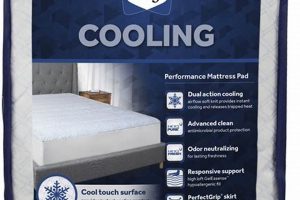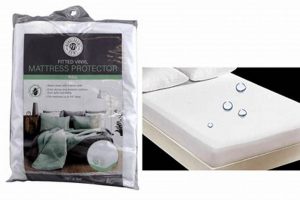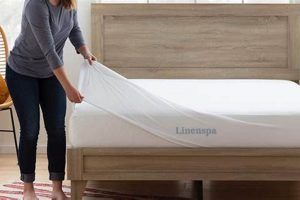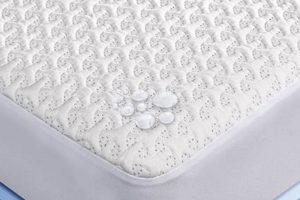The central question addresses the effectiveness of a specific bedding item in preventing infestation by parasitic insects that feed on human blood. These pests are known for their resilience and ability to hide in small crevices, making their elimination challenging once an infestation takes hold. A protective encasement seeks to create a barrier against these pests.
Employing such a barrier can offer a significant advantage in managing or preventing an outbreak. Historically, methods for controlling these infestations have been costly and inconvenient, often involving professional extermination services. A physical barrier represents a proactive and often more cost-effective approach to mitigate risks, safeguarding sleep environments and reducing reliance on chemical treatments.
The subsequent discussion will delve into the mechanisms by which such encasements function, the specific features to consider when selecting one, and the extent to which they contribute to an integrated pest management strategy. It will also address common misconceptions and offer practical advice on implementation for optimal effectiveness.
Tips for Utilizing Mattress Encasements Against Bed Bugs
The following recommendations provide guidance on selecting and implementing mattress encasements as part of a comprehensive strategy for managing the risk of bed bug infestations.
Tip 1: Select a Protector Specifically Labeled for Bed Bug Protection: Not all mattress protectors are created equal. Look for products explicitly advertised and tested to prevent bed bug entry and escape. Features such as tightly woven fabric and specialized zippers are crucial.
Tip 2: Ensure Proper Encasement Fit: A loose or poorly fitted protector provides potential entry points. Measure the mattress accurately and select a protector that fits snugly and completely encloses the mattress.
Tip 3: Inspect the Encasement Regularly for Damage: Tears, punctures, or zipper malfunctions compromise the protector’s effectiveness. Periodically examine the encasement and promptly repair or replace any damaged components.
Tip 4: Seal the Zipper with Bed Bug-Proof Tape: Even with specialized zippers, sealing the zipper closure with bed bug-proof tape adds an extra layer of protection. This prevents pests from escaping or entering through the zipper teeth.
Tip 5: Extend Protection to Box Springs: Bed bugs can infest box springs as well. Encase the box spring using a protector designed for that purpose to create a complete barrier.
Tip 6: Maintain Regular Cleaning Practices: Vacuum the encasement regularly, paying attention to seams and folds, to remove any potential pests or debris. While the encasement protects the mattress, it can still accumulate dust and allergens.
Tip 7: Implement Integrated Pest Management: Encasements are most effective when combined with other pest control measures. This may include regular inspections, professional treatments, and careful monitoring of luggage and belongings.
Adherence to these tips maximizes the effectiveness of mattress encasements in preventing and managing bed bug infestations, contributing to a healthier and more secure sleeping environment.
The subsequent sections will explore other aspects of bed bug prevention and control, including identifying infestations, choosing professional pest control services, and implementing long-term management strategies.
1. Effective physical barrier
The role of a mattress protector as an effective physical barrier is central to the query of its ability to stop bed bugs. The encasement’s primary function is to prevent bed bugs from accessing the mattress, either to establish a new infestation or to escape from an existing one. This barrier functions through specific design and material properties.
- Fabric Density and Weave
The fabric of a mattress protector designed to impede bed bugs features a tight weave with small pore sizes. This minimizes the potential for bed bugs, which are small and flat, to penetrate the material. The efficacy of the barrier depends on the integrity of the fabric, as even minor tears or openings can negate its protective properties.
- Sealed Seams and Zipper Enclosures
Seams and zipper closures represent potential weaknesses in the physical barrier. Bed bug-resistant protectors utilize sealed seams to prevent pests from entering or exiting through the stitching. Specialized zippers, often with additional sealing mechanisms, further reinforce the enclosure, ensuring complete isolation of the mattress.
- Durability and Resistance to Damage
The longevity and effectiveness of the physical barrier are directly correlated with its durability and resistance to damage. Protectors constructed from robust materials are less susceptible to tears, punctures, or abrasions that could compromise their integrity. Regular inspection and maintenance are essential to identify and address any damage promptly.
- Encasement of Entire Mattress
Complete encasement of the mattress is critical. Partial coverage leaves vulnerable areas exposed to infestation. The protector should fully enclose the mattress and box spring, creating a continuous barrier against bed bugs attempting to establish a presence.
The effectiveness of a mattress protector as a physical barrier against bed bugs is contingent upon these factors. While the encasement can significantly reduce the risk of infestation and contain existing populations, it is not a standalone solution. Integrated pest management strategies, including regular inspection, targeted treatments, and preventive measures, are necessary for comprehensive bed bug control.
2. Zippered, tight encasement required
The efficacy of a mattress protector in preventing or managing bed bug infestations is inextricably linked to the requirement of a zippered, tight encasement. This specification transcends the function of a simple mattress covering; it denotes a critical design feature necessary for effective pest control. Without a secure, sealed enclosure, the protector’s ability to impede bed bug activity is significantly compromised.
- Complete Isolation of the Mattress Core
A zippered, tight encasement provides complete isolation of the mattress core from the external environment. This isolation prevents bed bugs from accessing the interior of the mattress, where they typically harbor and breed. A properly sealed encasement effectively traps existing infestations within the mattress, preventing their spread, and simultaneously blocks new infestations from establishing themselves. For example, a standard mattress cover without a zipper closure would not prevent bed bugs from crawling underneath and infesting the mattress.
- Prevention of Escape and Entry
The zippered closure, when properly secured, eliminates potential entry and exit points for bed bugs. These pests are adept at exploiting even minute openings, and a loose or unsealed encasement renders the protective barrier ineffective. A tight-fitting encasement ensures that the zipper is flush against the mattress material, minimizing gaps. The zipper itself must be specifically designed to prevent bed bug penetration, often incorporating features such as tightly woven fabric or interlocking teeth. Illustratively, a protector with a wide-toothed zipper or visible gaps along the closure is insufficient for bed bug protection.
- Durability Under Stress
A zippered, tight encasement must maintain its integrity under the stresses of regular use. Movement on the mattress, cleaning, and general wear and tear can compromise the enclosure’s effectiveness if the zipper or seams are weak. High-quality encasements utilize durable materials and reinforced stitching to withstand these stresses. An example would be an encasement constructed with reinforced seams and a heavy-duty zipper that remains sealed even with repeated use and cleaning.
- Material Permeability
While the primary function is to prevent bed bug penetration, the material of the encasement must also be sufficiently breathable to prevent moisture buildup within the mattress. A non-breathable encasement can create a damp environment conducive to mold growth, which can degrade the mattress and potentially attract other pests. The ideal material combines a tight weave that blocks bed bugs with sufficient air permeability to allow for ventilation. One practical example includes protectors fabricated from microfiber fabrics with a pore size too small for bed bugs to pass through but still allowing air circulation.
In conclusion, the zippered, tight encasement is not merely an optional feature; it is a fundamental requirement for an effective mattress protector in the context of preventing or managing bed bug infestations. Without this design element, the protector’s ability to isolate the mattress, prevent pest escape and entry, and maintain its integrity under stress is significantly diminished, thereby negating its intended purpose.
3. Prevents existing infestations
The notion that a mattress protector “prevents existing infestations” requires careful consideration within the context of whether it stops bed bugs. The function of a mattress encasement is primarily containment, rather than eradication. A bed bug-certified encasement, properly installed, traps bed bugs already residing within the mattress, thereby preventing their dispersal and further propagation. A real-world example is a scenario where an individual unknowingly purchases a used mattress harboring a nascent bed bug population. Enclosing the mattress in a protector effectively confines the pests within, mitigating the risk of them spreading to other furniture or rooms in the residence. This containment serves a vital role in slowing down or halting the expansion of an infestation.
It is crucial to acknowledge that the encasement, while preventing escape, does not actively kill the bed bugs contained within. The trapped pests will continue to live and potentially reproduce within the confines of the encasement. Over time, they will eventually die due to starvation, but this process can take several months. Therefore, the practical significance of this understanding lies in the recognition that the encasement is a containment tool, not a standalone solution for complete eradication. Other integrated pest management strategies, such as professional treatments or heat remediation, are often necessary to fully eliminate the infestation. For example, one might utilize the encasement in conjunction with regular vacuuming of the surrounding area to remove any stray bed bugs that may have escaped prior to the encasement’s installation.
In summary, while a mattress protector contributes to managing an existing infestation by preventing its spread, it does not inherently eliminate the pests. Its effectiveness hinges on proper installation, the quality of the encasement itself, and its integration within a more comprehensive pest control plan. Challenges include ensuring complete sealing of the encasement and addressing potential infestations in other furniture or areas within the dwelling. The encasement’s role as a preventive measure is more definitive; it stops new infestations from taking hold within the mattress, underscoring its importance as a proactive component of bed bug management.
4. Must be bed bug certified
The assertion that a mattress protector “must be bed bug certified” is a critical component in determining its effectiveness in stopping bed bugs. This certification signifies that the protector has undergone rigorous testing and meets specific standards for preventing bed bug penetration and escape. Without such certification, the protector’s claim to safeguard against bed bugs remains unsubstantiated.
- Fabric Pore Size and Weave Density
Bed bug certification often mandates specific fabric pore sizes and weave densities. These specifications ensure that the fabric is sufficiently tight to prevent bed bugs, which are small and flat, from passing through. A certified protector will have undergone testing to confirm its fabric meets these requirements. An uncertified protector may have a looser weave, allowing bed bugs to penetrate and render it ineffective.
- Zipper and Seam Integrity
Certification also encompasses the integrity of the zipper and seams. These areas are potential weak points where bed bugs could enter or escape. Certified protectors must demonstrate that their zippers and seams are bed bug-proof, often involving specialized designs and sealing techniques. For example, a certified protector might employ a zipper with interlocking teeth and a fabric flap to completely seal the closure, while an uncertified protector might have a standard zipper with gaps allowing for bed bug passage.
- Durability and Longevity
Certified protectors are typically subjected to durability testing to ensure they can withstand regular use and cleaning without compromising their bed bug-proof qualities. This testing may involve simulating wear and tear to assess the fabric’s resistance to tearing or puncture. The implication is that a certified protector is more likely to maintain its effectiveness over time compared to an uncertified product that may degrade quickly.
- Third-Party Validation
The most reliable certifications come from independent third-party organizations that specialize in testing and certifying products for bed bug resistance. These organizations employ standardized testing protocols and provide unbiased assessments of a protector’s performance. An example would be a certification from an entomological laboratory that verifies the protector’s ability to block bed bug penetration under controlled conditions. This third-party validation adds credibility to the protector’s claims and provides consumers with greater confidence in its effectiveness.
In summary, the “must be bed bug certified” criterion is paramount in determining whether a mattress protector will effectively stop bed bugs. Certification ensures that the protector meets specific standards for fabric density, zipper and seam integrity, durability, and third-party validation. Consumers should prioritize certified protectors to maximize their chances of preventing or managing bed bug infestations, and be aware of false claims.
5. Regular inspection essential
The effectiveness of a mattress protector in preventing or managing bed bug infestations is intrinsically linked to the principle that regular inspection is essential. The installation of a protective encasement does not obviate the need for ongoing vigilance. The structural integrity of the protector, its seams, and its zipper closure can be compromised over time, either through normal wear and tear or accidental damage. A compromised encasement provides an avenue for bed bugs to bypass the intended barrier, rendering the initial investment and effort ineffective. For example, a small tear caused by a sharp object during sheet changing, if left undetected, negates the protector’s purpose.
Regular inspection serves as a proactive measure to identify and address any breaches in the encasement’s integrity. It allows for the timely repair or replacement of damaged protectors, preventing bed bugs from establishing a foothold within the mattress. Furthermore, inspection extends beyond the encasement itself to encompass the surrounding areas, including the bed frame, headboard, and nearby furniture. These areas can serve as harborage points for bed bugs, even if the mattress is adequately protected. Therefore, a comprehensive inspection regimen ensures that the entire sleeping environment remains free from infestation. The frequency of inspections depends on various factors, including the level of risk and the prevalence of bed bugs in the surrounding environment; however, a minimum of monthly inspections is recommended.
In summary, regular inspection is an indispensable component of a bed bug management strategy employing mattress protectors. It is not sufficient to simply install an encasement and assume complete protection. Ongoing vigilance is necessary to detect and address any breaches in the barrier, ensuring that the protector continues to perform its intended function. The practical significance of this understanding lies in the realization that a mattress protector is a tool, not a panacea, and that its effectiveness depends on diligent maintenance and monitoring.
6. Doesn't kill bed bugs
The statement “Doesn’t kill bed bugs” is pivotal to a proper understanding of “will a mattress protector stop bed bugs.” A mattress protector, specifically a bed bug-certified encasement, functions as a physical barrier, not an extermination device. Its primary role is to prevent bed bugs from accessing the mattress, thereby containing existing infestations within and preventing new infestations from establishing themselves. An example is a scenario where a mattress already harbors bed bugs; enclosing it will trap those pests but will not eliminate them. This distinction is crucial, as relying solely on a mattress protector while ignoring the existing infestation will not resolve the problem. Instead, the bugs will remain within the mattress, potentially seeking alternative food sources if given the opportunity. The practical significance of this is understanding that a mattress protector is a containment measure that must be coupled with other extermination or management methods for effective bed bug control.
Further analysis reveals that the “Doesn’t kill bed bugs” aspect underscores the importance of integrated pest management (IPM) strategies. IPM emphasizes a multifaceted approach that combines preventive measures, monitoring, and control tactics to minimize pest populations and associated risks. In the context of bed bugs, IPM may involve regular inspections, vacuuming, targeted treatments (such as insecticides or heat remediation), and the use of mattress protectors as a containment tool. The mattress protector prevents bed bugs from infesting the mattress, but the other IPM strategies actively work to eliminate the bed bugs present in the surrounding environment. An example is using a steam cleaner to treat the bed frame and baseboards while simultaneously enclosing the mattress with a protector. This combined approach addresses both the existing infestation and the risk of re-infestation.
In conclusion, while a mattress protector plays a valuable role in containing bed bug infestations and preventing new ones, it does not possess the inherent ability to kill the pests. The recognition of this limitation is essential for developing and implementing effective bed bug management strategies. The challenge lies in ensuring that the mattress protector is used as part of a comprehensive approach that addresses both containment and extermination. Failure to do so can result in a prolonged infestation and increased difficulty in achieving complete eradication, and underscores the core connection of preventing “will a mattress protector stop bed bugs” without completely solving existing issues.
7. Integrated approach needed
The phrase “integrated approach needed” highlights that the effectiveness of a mattress protector in stopping bed bugs is contingent upon its deployment within a broader pest management strategy. A singular reliance on a mattress protector, without addressing other potential sources of infestation or implementing complementary control measures, is unlikely to achieve complete success.
- Identification and Treatment of Infested Areas
A comprehensive approach necessitates a thorough inspection to identify all areas harboring bed bugs, not just the mattress. Bed frames, headboards, baseboards, carpets, and furniture in close proximity to the bed can serve as harborages. Targeted treatments, such as vacuuming, steam cleaning, or the application of appropriate insecticides, should be applied to these areas. An example is a situation where a mattress is encased, but bed bugs persist in the nearby nightstand, from which they can continue to feed on the sleeping individual. This underscores the need to treat all infested zones, not just the immediate sleeping surface.
- Preventive Measures and Monitoring
Preventing new infestations and monitoring for signs of ongoing activity are essential components of an integrated approach. This includes inspecting luggage after travel, regularly laundering bedding, and being vigilant for signs of bed bugs, such as shed skins, fecal spots, or live insects. Furthermore, implementing preventive measures, such as sealing cracks and crevices in walls and floors, can reduce potential harborage sites. An analogy is a homeowner who installs a mattress protector but fails to inspect their luggage after a trip, inadvertently introducing new bed bugs into the environment. This illustrates that an ongoing commitment to prevention and monitoring is necessary to maintain a bed bug-free environment.
- Professional Pest Control Services
In cases of severe or persistent infestations, professional pest control services may be required. Licensed pest control operators have access to specialized equipment and insecticides that are not available to the general public. They can also conduct thorough inspections to identify hidden harborages and develop customized treatment plans tailored to the specific situation. A scenario is a multi-unit dwelling where bed bugs have spread from one apartment to another. In such cases, professional intervention is often necessary to coordinate treatment efforts and prevent re-infestation. This underscores that in certain situations, a DIY approach may be insufficient, and professional expertise is required.
- Non-Chemical Control Methods
An integrated approach may also incorporate non-chemical control methods, such as heat treatment or cryotherapy. Heat treatment involves raising the temperature of an infested area to a lethal level for bed bugs, while cryotherapy involves freezing them with liquid nitrogen. These methods can be effective in eliminating bed bugs without the use of insecticides. An example is using portable heaters to raise the temperature of a room to above 120F, killing bed bugs in the process. However, these methods require specialized equipment and expertise and may not be feasible in all situations. The key is to use a combination of methods to achieve comprehensive control.
In conclusion, the efficacy of a mattress protector in stopping bed bugs is fundamentally intertwined with the implementation of an integrated pest management strategy. A mattress protector serves as a valuable tool in preventing bed bugs from infesting the mattress and containing existing infestations. However, it is not a standalone solution. A comprehensive approach that addresses all potential sources of infestation, incorporates preventive measures, and may involve professional pest control services is essential for achieving long-term bed bug control. A metaphor would be a fence to keep livestock from escaping, however, if the gate is left open the fence is rendered useless.
Frequently Asked Questions
The following questions address common concerns regarding the effectiveness of mattress protectors in the context of bed bug prevention and management. It is important to consult reliable sources and consider the information within the broader scope of pest management strategies.
Question 1: Does a standard mattress cover offer protection against bed bugs?
No, a standard mattress cover generally provides limited protection. Bed bug-certified encasements possess specific features, such as tightly woven fabric and specialized zippers, that are necessary to prevent bed bug penetration. A standard cover lacks these features.
Question 2: How often should a mattress protector be inspected for damage?
A mattress protector should be inspected at least monthly for any signs of tears, punctures, or zipper malfunctions. Prompt repair or replacement is essential to maintain its effectiveness. If a known or suspected bed bug infestation exists, inspections should be more frequent.
Question 3: Can bed bugs live on a mattress protector itself?
While a bed bug-certified encasement prevents bed bugs from infesting the mattress, they can potentially live on the exterior surface of the protector. Regular vacuuming of the protector’s surface is recommended to remove any potential pests or debris.
Question 4: Is it possible to eliminate a bed bug infestation solely by using a mattress protector?
No, a mattress protector alone is insufficient to eliminate a bed bug infestation. It serves as a containment measure, but integrated pest management strategies are necessary to address the overall infestation.
Question 5: Are all “bed bug-proof” mattress protectors equally effective?
No, the effectiveness of “bed bug-proof” mattress protectors can vary. It is crucial to select protectors that are certified by reputable third-party organizations and meet specific standards for bed bug resistance.
Question 6: Does encasing a mattress prevent bed bugs from biting?
Enclosing the mattress effectively prevents bed bugs within the mattress from biting. It may stop bed bugs entering the mattress. Bed bugs can still exist elsewhere and bite though.
The responses to these inquiries emphasize that a mattress protector is a valuable tool in bed bug management, but its effectiveness is contingent upon proper selection, installation, maintenance, and integration within a comprehensive pest control plan.
The next section will delve into the costs associated with bed bug infestations and the potential savings offered by proactive prevention measures.
Conclusion
The investigation into whether “will a mattress protector stop bed bugs” reveals a nuanced reality. While a certified, properly installed mattress encasement acts as a crucial barrierpreventing infestation and containing existing populationsit does not constitute a singular solution. Its effectiveness is maximized when integrated into a comprehensive pest management strategy that includes regular inspections, targeted treatments, and preventative measures addressing all potential harborages. The encasement, therefore, serves as a critical component within a broader defense, not a standalone remedy.
The ongoing vigilance and adoption of a multi-faceted approach remain paramount in safeguarding against the pervasive threat of bed bugs. A mattress protector represents a significant investment in preventative care, but sustained diligence is necessary to realize its full potential and ensure a pest-free sleeping environment. In the absence of such commitment, the encasement’s benefit is substantially diminished, leaving individuals vulnerable to continued or renewed infestations.







